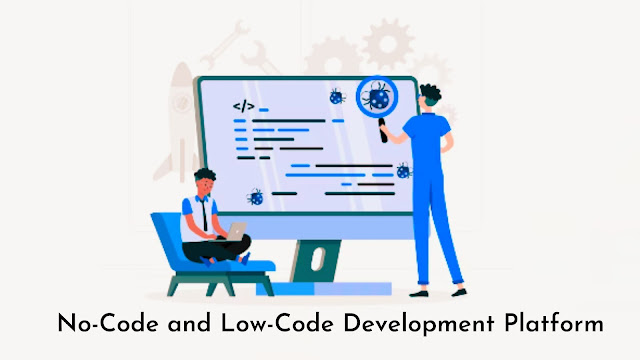The Rise of No-Code and Low-Code Platforms
Software development has become a crucial component of business success in today's fast-paced digital environment. Yet, the conventional method of developing custom software can be costly, time-consuming, and demand specific technical expertise. No-code and low-code platforms have become popular as a new method of software development to handle these problems.
No-code and low-code platforms are development environments that let anyone create software applications even if they have little to no coding skills. Users can build complicated apps using these platforms' visual interfaces, pre-built components, and drag-and-drop features without writing a single word of code.
Is no-code different from low-code platforms?
Although "no-code" and "low-code" are sometimes used synonymously, they refer to two different methods of software development.
No-code platforms: Designed for users without coding experience
No-code platforms are made for users with no prior coding knowledge. Users can easily drag and drop pre-built components and templates into place on these platforms to develop applications. Businesses that need to quickly construct simple applications but lack the funds or resources to hire a specialized development staff may find no-code platforms to be especially helpful.
Businesses that need to develop apps that can be readily updated and maintained by non-technical staff should consider no-code platforms. Businesses don't need to pay specialized development teams to maintain and upgrade applications because no-code platforms don't require any coding experience.
Low-code platforms: A middle ground between coding and no-coding
Low-code platforms are made to make it simple and quick for users with some coding experience to construct applications. In most cases, these platforms offer a visual user interface that enables users to drag and drop pre-built components and specify the logic and business rules that power the application. Low-code platforms provide a compromise between traditional coding and no-code platforms by letting users use their current coding skills while yet facilitating an easier development process.
Businesses that need customized apps but lack the funds or resources to hire a specialized development team may find low-code platforms to be very helpful. Without the assistance of IT or development teams, business users may quickly construct applications and iterate on them using a low-code platform.
Why No-Code/Low-Code Platforms Gaining Popularity?
The adoption of no-code and low-code platforms has been on the rise due to several reasons.
Here are some of the key factors that have contributed to the popularity of these platforms:
A. Increased demand for software development
The demand for software development has significantly increased as a result of organizations going digital and the popularity of technology-based solutions. But the conventional method of developing software, in which a group of programmers writes code from scratch, is frequently time-consuming and expensive. Platforms with no-code and low-code support provide a different option that enables companies to create software more quickly and affordably.
B. Shortage of skilled developers
Developers with the necessary skills are in great demand in the technology sector. Businesses have found it challenging to locate and hire qualified developers as a result of this shortage. Businesses can use their current workforce to construct software applications using no-code and low-code platforms, which eliminates the need to hire new developers.
C. Need for faster time-to-market
In today's fast-paced business environment, speed is crucial. To keep ahead of the competition, businesses must build and deploy software applications quickly. Using no-code and low-code platforms, enterprises may create and deploy software applications more quickly than with traditional software development, doing it in a matter of days or weeks as opposed to months.
D. Increased ease of use of no-code/low-code platforms
Platforms with no code or low code have improved in usability recently. It is now simpler for non-technical users to create software applications without writing a single line of code thanks to the availability of easy visual interfaces and pre-built templates. No-code and low-code platforms are now more widely available to companies of all sizes because to their increasing usability.
E. Cost savings for businesses
Comparing no-code and low-code platforms to conventional software development, significant cost savings are possible. Because the development process moves considerably more quickly, they lessen the requirement for employing extra developers. Low-code and no-code platforms also require less upkeep and support, which allows companies to save even more money.
Advantages of No-Code/Low-Code Platforms
No-code and low-code platforms offer several advantages over traditional software development.
Here are some of these advantages:
A. Faster time-to-market
The ability to develop and deploy software applications much faster than traditional software development methods is one of the primary benefits of no-code and low-code platforms. Users can quickly create functional prototypes using pre-built components and templates and iterate on them until they meet their requirements.
B. Reduced costs
When compared to traditional software development, no-code and low-code platforms offer significant cost savings. They eliminate the need for additional developers, and the development process is much faster, resulting in lower development costs. Furthermore, no-code and low-code platforms necessitate less maintenance and support, resulting in additional cost savings for businesses.
C. Democratized software development
Non-technical users can contribute to software development using no-code and low-code platforms. Because of the democratization of software development, businesses can use their existing workforce to create software applications, reducing the need for additional developers. This also means that developers will be able to concentrate on more complex and mission-critical tasks.
D. Increased agility
Platforms with no-code and low-code enable businesses to respond to changing market demands more quickly. Businesses can gain a competitive advantage by quickly developing and deploying software applications that can be adapted to meet changing customer needs.
E. Improved collaboration
No-code and low-code platforms make it easier for developers and business users to collaborate. With a visual interface and pre-built components, developers can easily collaborate with business users to create software applications that meet their needs, resulting in better software applications and more satisfied customers.
The Future of No-Code/Low-Code Platforms
No-code and low-code platforms have the potential to revolutionize the software development industry.
Let’s explore some of the potential impacts of these platforms on the industry:
A. Increased demand for no-code/low-code developers
As more businesses adopt no-code and low-code platforms, there will be a greater demand for developers who are skilled in their use. This demand may result in the creation of a new job market for developers who specialize in these platforms, opening up new career opportunities.
B. Increased competition in the software development industry
Businesses of all sizes will be able to develop software applications more quickly and at a lower cost thanks to no-code and low-code platforms. Because businesses will be able to compete with larger, more established companies, there will be more competition in the software development industry.
C. Shift in software development workflows
The proliferation of no-code and low-code platforms may result in a shift in software development workflows. The traditional divide between developers and business users may disappear if non-technical users can contribute to software development. This could result in more collaborative workflows in which developers collaborate closely with business users to create software applications.
D. Increased innovation
No-code and low-code platforms may enable the development of more innovative software solutions. Businesses may be more willing to experiment with new ideas and technologies if they can quickly create and test prototypes, leading to more innovative solutions.
E. Potential challenges
While no-code and low-code platforms have many advantages, they can also be challenging. One of the main concerns is the possibility of security flaws, as non-technical users may be unaware of security best practices. Furthermore, the quality of software applications developed using these platforms may be lower than that of traditional software development methods.
The Role of Citizen Developers
Citizen developers are non-technical users who create software applications using no-code and low-code platforms without the need for traditional programming skills. These users are typically experts in their respective domains, such as marketing, finance, or operations, and they use no-code or low-code platforms to create applications that automate their processes.
Importance of Citizen Developers in No-Code/Low-Code Development
Citizen developers play an important role in no-code and low-code development because they allow non-technical users to contribute to software development. This democratization of software development allows businesses to create applications more quickly and efficiently.
Furthermore, citizen developers are frequently closer to the end users of the applications they create, which can result in more user-centric software applications.
Potential Challenges of Citizen Development
While citizen development has many benefits, it may also have some drawbacks. Citizen developers, for example, may be unaware of security best practices, resulting in security vulnerabilities.
Furthermore, the quality of software developed by citizen developers may be lower than that of professional developers. Finally, citizen developers may lack the technical knowledge necessary to create more complex applications.
Choosing the Right No-Code/Low-Code Platform
Selecting the right no-code/low-code platform is critical to the success of any software development project.
Let’s explore the key factors to consider when selecting a platform, the top no-code and low-code platforms and their features, and best practices for evaluating and choosing a platform:
A. Key Factors to Consider When Selecting a Platform
Businesses should consider several key factors when selecting a no-code/low-code platform. These factors include the complexity of the application to be developed, the platform's scalability, the availability of pre-built templates and integrations, the platform's level of customization, and the platform's security features.
B. Top No-Code/Low-Code Platforms and Their Features
There are numerous no-code/low-code platforms on the market, each with its own set of features and capabilities. AppSheet, Airtable, Bubble, Mendix, OutSystems, and Salesforce Lightning are among the top platforms. These platforms include drag-and-drop interfaces, pre-built templates and integrations, integration with third-party tools, and advanced security features.
C. Best Practices for Evaluating and Choosing a Platform
Several best practices should be followed by businesses when evaluating and selecting a no-code/low-code platform. These include defining the application's requirements, conducting a thorough evaluation of the platform's features and capabilities, assessing the platform's level of support and training, and evaluating the platform's pricing model and overall cost.
Businesses must also consider the platform's long-term viability, including its roadmap for future development, ability to integrate with other tools and technologies, and scalability. Furthermore, businesses should consider the platform's level of customization, as well as its security features and compliance with industry standards and regulations.
Conclusion
No-code and low-code platforms are revolutionizing software development, enabling businesses to create high-quality applications more quickly and at a lower cost. These platforms enable a new generation of citizen developers to participate in the software development process, democratizing technology access and driving innovation.
We can expect even more innovation and growth in the industry as no-code and low-code platforms continue to evolve. Businesses can develop applications faster, more efficiently, and with greater flexibility by leveraging these platforms, allowing them to stay ahead of the competition and meet the changing needs of their customers.




Comments
Post a Comment